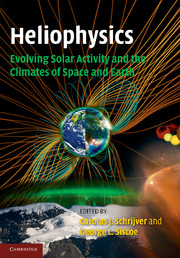Book contents
- Frontmatter
- Contents
- Preface
- 1 Interconnectedness in heliophysics
- 2 Long-term evolution of magnetic activity of Sun-like stars
- 3 Formation and early evolution of stars and protoplanetary disks
- 4 Planetary habitability on astronomical time scales
- 5 Solar internal flows and dynamo action
- 6 Modeling solar and stellar dynamos
- 7 Planetary fields and dynamos
- 8 The structure and evolution of the three-dimensional solar wind
- 9 The heliosphere and cosmic rays
- 10 Solar spectral irradiance: measurements and models
- 11 Astrophysical influences on planetary climate systems
- 12 Assessing the Sun–climate relationship in paleoclimate records
- 13 Terrestrial ionospheres
- 14 Long-term evolution of the geospace climate
- 15 Waves and transport processes in atmospheres and oceans
- 16 Solar variability, climate, and atmospheric photochemistry
- Appendix I Authors and editors
- List of illustrations
- List of tables
- References
- Index
- Plates
11 - Astrophysical influences on planetary climate systems
Published online by Cambridge University Press: 05 April 2013
- Frontmatter
- Contents
- Preface
- 1 Interconnectedness in heliophysics
- 2 Long-term evolution of magnetic activity of Sun-like stars
- 3 Formation and early evolution of stars and protoplanetary disks
- 4 Planetary habitability on astronomical time scales
- 5 Solar internal flows and dynamo action
- 6 Modeling solar and stellar dynamos
- 7 Planetary fields and dynamos
- 8 The structure and evolution of the three-dimensional solar wind
- 9 The heliosphere and cosmic rays
- 10 Solar spectral irradiance: measurements and models
- 11 Astrophysical influences on planetary climate systems
- 12 Assessing the Sun–climate relationship in paleoclimate records
- 13 Terrestrial ionospheres
- 14 Long-term evolution of the geospace climate
- 15 Waves and transport processes in atmospheres and oceans
- 16 Solar variability, climate, and atmospheric photochemistry
- Appendix I Authors and editors
- List of illustrations
- List of tables
- References
- Index
- Plates
Summary
Introduction
The planets and the Sun together form a coupled system, the so-called solar system, which is located in a s piral arm of the Milky Way galaxy. The solar system has existed for 4.6 billion years. Its formation took only between 50 and 100 million years (Chapter 3). According to the nebular hypothesis, a large cloud of gas started to contract under self-gravity. Conservation of angular momentum led to a rotating disk. In the center of this disk mass concentrated into a so-called proto-Sun which grew larger and larger. After reaching a temperature of about 15 million K in the core, nuclear fusion processes started turning hydrogen into helium.
In the inner part of the disk, small planetesimals were formed, which by aggregating more mass became the terrestrial planets (Mercury, Venus, Earth, and Mars). The release of potential energy and the impact of particles produced molten spheres causing a chemical differentiation with denser material sinking to the center and with a loss of volatile components. In the outer disk, lower temperatures prevailed allowing the aggregation of volatile matter such as ices and gases. The result was several larger planets with lower densities (Jupiter, Saturn, Uranus, and Neptune). For a more detailed discussion of the formation and evolution of stars and their planets we refer to Chapter 3.
- Type
- Chapter
- Information
- Publisher: Cambridge University PressPrint publication year: 2010



